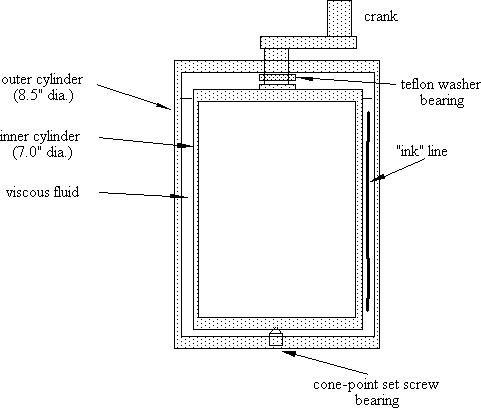Food coloring in glycerine is mixed by turning a drum, then unmixed by reversing. Has entropy decreased?
What it shows:
Ink is squirted into a fluid and mixed in until it disappears. By precisely undoing the motions in the reverse direction, the ink becomes unmixed! The demonstration seems to defy thermodynamics in that it appears that entropy decreases, but in actuality the reversible mixing is made possible by insuring that the mixing/unmixing is done without turbulence.
How it works:
The space between two, transparent and concentric cylinders is filled with a viscous fluid (glycerine or Karo™ syrup). One or more lines of colored fluid are also injected into this fluid reservoir, parallel to the axis of the cylinder(s). When the inside cylinder is slowly rotated (by means of a crank) with respect to the outside cylinder, the lines of colored fluid become mixed with the rest of the fluid. Several revolutions renders the mixture completely clear and "mixed". If one now reverses the direction of rotation, the colored fluid lines reappear by "unmixing" after the same number of rotations in the opposite sense.
The design and operation of the apparatus insures laminar flow. Diffusion processes are, of course, much much slower than the time scale of the demonstration. As one cylinder is rotated w.r.t. the other, one can simply think of layers of fluid being displaced without involving turbulence, the boundary layer next to the inner rotating cylinder being displaced the most and the layer adjacent to the outside cylinder the least. Counter rotation slips these layers back into place.
Setting it up:
The fluid should be of high viscosity. We have used glycerine or corn syrup. The apparatus capacity is 2.2 to 2.3 liters; thus about 5 bottles of Light Corn Syrup should suffice. It will be necessary to add some kind of preservative 1 to the corn syrup if you plan to leave it in the apparatus for extended periods. Mold does not grow in the glycerine, but glycerine costs about $50/gallon.
The "ink" should have similar viscosity to the fluid you use. A few drops of food coloring mixed into about 10 ml of fluid works well. A vertical "line" of colored fluid is squirted into the apparatus by means of a hypodermic syringe fitted with a large needle and long stainless-steel extension tube. Alternatively, a 5 ml volumetric pipette fitted with a pipette rubber squeeze-bulb also works well. After the demonstration, the dye can be thoroughly mixed (by a few dozen turns) so that the syrup (or glycerine) can be used again. This will give you many uses before you have to discard it.
Comments:
The demonstration is quite dramatic. Using different colors for each of the injected lines adds to the visual appeal. The presentation of this demonstration can be further enhanced by first squirting some food coloring into a large beaker of water and stirring the mixture (with a spoon) until a uniform color is achieved. This provides not only a visual contrast for the mixing/unmixing demo but also a source for further discussion.
The demonstration can also be used as a mechanical analog of spin echoes in nuclear magnetic resonance.
As far as we know, the original demonstration is due to John P. Heller of Socony Mobil Oil Co. 2 Our present apparatus was fabricated by Harvard student Alyn Kelly ('90) who actually made one for each of the sixteen NECUSE 3 institutions! Many thanks. The unmixing never fails to illicit a long "Ooooh" from the audience. An "Ooooh" is close enough to a "Wow".
References:
J.P. Heller, Am J Phys 28, 348-353 (1960). "An Unmixing Demonstration"
This reference provides the mathematical description (Navier-Stokes equations) of the mixing transformation in the geometry of the Couette viscometer, which is a similar geometry to our apparatus.
R. Brewer and E. Hahn, Scientific American, Dec 1984, p 50. "Atomic systems that have decayed from some ordered states can be induced to recover their initial order."
1 One such product is Consan Triple Action 20 (algicide, fungicide, bacteriacide) made by Del Tek Inc., 14221 Suburban Garden Rd., P.O. Box 179, Pearland, TX 77588. 1/2 tsp is sufficient.
2 John P. Heller, Am J Phys 28, 348-353 (1960) "An Unmixing Demonstration." Heller uses the geometry of a Couette viscometer and solves the Navier-Stokes equation for the mixing transformation.
3 New England Consortium for Undergraduate Science Education